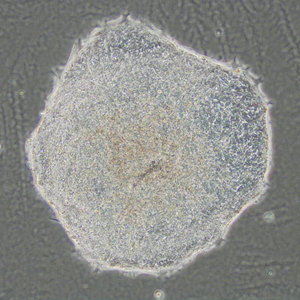Aug. 8, 2006 Research Highlight Biology
Awakening of human embryonic stem cells
Repression and preferential activation of dormant genes that regulate embryonic development revealed by genome mapping
 Figure 1: Undifferentiated human embryonic stem cells
Figure 1: Undifferentiated human embryonic stem cells
Embryonic stem cells are like sleepwalkers—seemingly awake, but only semi-functional (Fig. 1). Most of the developmental genes that will determine their form and function remain dormant and unresponsive to calls by cell growth factors to commit and specialize.
What keeps them in this twilight state? In Cell 1, RIKEN and US researchers report the results of a genome-wide scan of human embryonic stem (ES) cells for DNA sequences occupied by SUZ12, one of the Polycomb group of proteins. First described in Drosophila fruit fly embryos, Polycomb group proteins are highly conserved: they remain almost identical in human and fly, despite half a billion years of evolution.
Researchers from RIKEN’s Center for Allergy and Immunology in Yokohama, and RIKEN’s BioResource Center in Tsukuba, working with US teams at the Whitehead Institute of MIT, found the highly conserved sequences scattered at multiple sites in more than 200 dormant genes that code for almost the entire complement of proteins regulating embryonic development.
The DNA sequences occupied by SUZ12 form docking sites for a cluster of proteins, the Polycomb Repressive Complex 2 (PRC2), that silences genes by locally modifying chromatin—the matrix of DNA and protein that forms the chromosomes.
In this dormant state, the genes’ DNA remains tightly coiled around its histone protein ‘reels’, blocking access by enzymes that will eventually copy their DNA code into messenger RNAs.
The researchers found that the 200-plus genes targeted by the PRC2 repressor complex are preferentially activated when ES cells begin to differentiate.
“The gene-expression program of ES cells must allow these cells to maintain a pluripotent state but also allow for differentiation into more specialized states when signaled to do so,” the researchers note in their Cell 1 publication.
Polycomb-group proteins are essential for early embryonic development in all animals, but their role in human embryonic development has been unclear. Regulatory genes repressed by PRC2 include the HOX genes that create the embryo’s body ‘plan’, and the FOX genes involved in axial patterning of the embryo. PRC2 also represses gene families involved in forming the nervous system, vascular system, tissue patterning, and in specifying cell fate.
The researchers say that learning how ES cells switch to more specialized states may be the key to realizing the therapeutic potential of ES cells, and further understanding of early embryonic development.
References
- 1. Lee, T.I., Jenner, R.G., Boyer, L.A., Guenther, M. G., Levine, S.S., Kumar, R. M., et al. Control of developmental regulators by Polycomb in human embryonic stem cells. Cell 125, 301–313 (2006). doi: 10.1016/j.cell.2006.02.043
